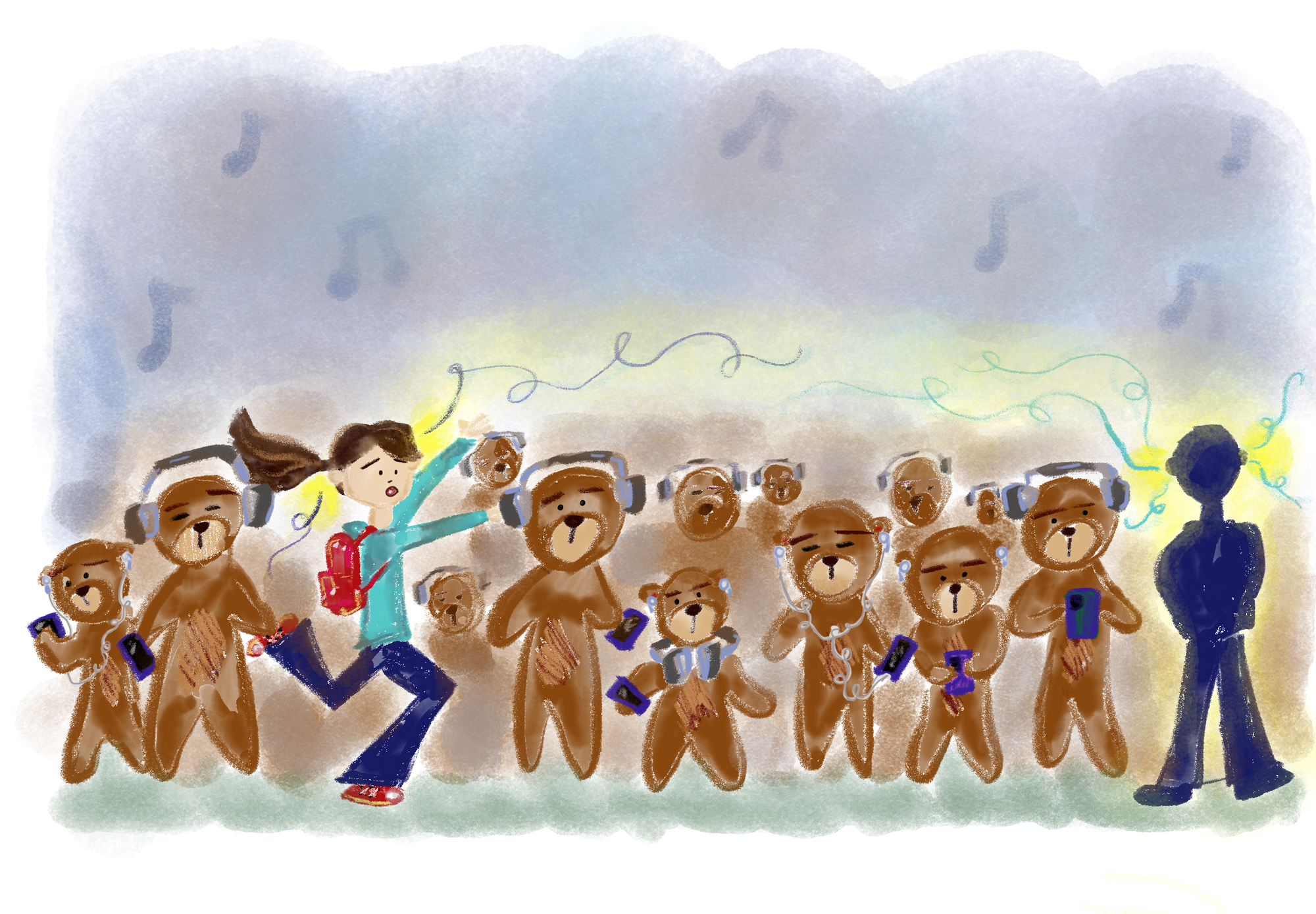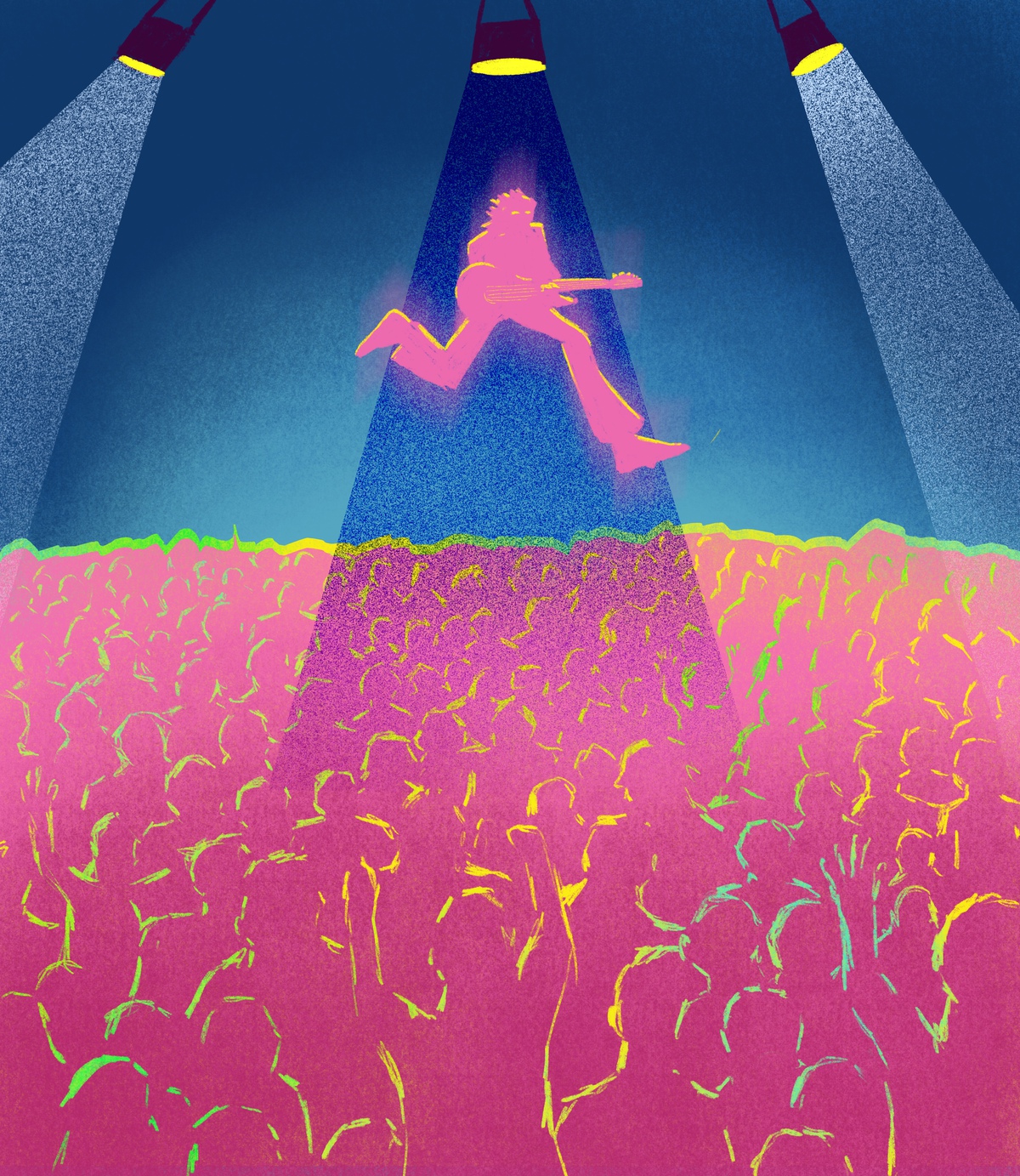Opinion: Using headphones increases social isolation, creates an individualistic society

(Kelly Gee/Daily Bruin)
By Kirsten Brehmer
May 23, 2024 11:37 p.m.
This post was updated July 7 at 5:26 p.m.
Like battleworthy armor, my headphones streaming Taylor Swift’s latest drop shield me from the usual campus chaos.
For many students at UCLA, headphones have become a permanent accessory and symbol of college culture.
Don’t get me wrong, I love listening to my specially curated Spotify playlists that are in tune with my wide range of moods alone. Nevertheless, I’ve increasingly noticed how headphones block us off from the rest of the world.
“I feel like when I put on my headphones, I’m kind of transported to a different realm. So it can be a good thing, but it can also be a bad thing,” said Hiyab Misghina, a fourth-year political science student. “It can make you very detached from reality.”
Ever since I entered UCLA as a transfer student this fall, I’ve been searching for a friendly connection wherever I can find it. Although the odds seem to be in my favor attending a campus with over 30,000 undergraduate students, it’s hard to spark conversation with someone when you’re also competing against a blockade of sound.
Jaimie Arona Krems, an assistant psychology professor who specializes in the social psychology of friendships, said headphone users may create barriers between themselves and those around them.
“By wearing headphones, you might be – whether or not you mean it – signaling to other people that you don’t want to be talked to,” Krems said. “And that can make people less likely to talk to you. You are less welcoming.”
When I’m wearing earbuds, I’m implicitly communicating that I don’t want to communicate. It’s a nonverbal statement that headphones present to those around us.
“There is a tacit understanding of your preference at that moment,” said Kristi Brown-Montesano, a musicology lecturer at the Herb Alpert School of Music. “And I think when combined with a kind of ‘I see you, but hey I can’t talk right now’ gesture, everybody understands that.”
To be transparent, I commonly avoid awkward encounters with clubs stationed along Bruin Walk by wearing headphones that scream, “Please move on.”
Since technological advancements continue to give us control over our personal environment, we are creating a society of individuals rather than communities.
According to Timothy Taylor, an ethnomusicology professor at the Herb Alpert School of Music, the ability to cater to our musical tastes so easily is creating a hyper-individualization of American culture.
As technology continues to improve, its contribution to helping create meaningful human connections is counterproductive and may reinforce isolation. Even the U.S. Department of Health and Human Services recognizes the widespread feeling of loneliness affecting around half of U.S. adults before COVID-19.
“There is some level where I feel like we are learning not to talk to people we don’t know,” Montesano-Brown said.
I recognize in myself a consistent hesitancy when trying to talk to people whom I consider strangers. Because of my own self-conscious anxieties, my social battery seems to always be running low.
Loneliness can often be accompanied by mental illnesses, such as generalized anxiety disorder and major depressive disorder.
“I know people who are socially anxious that put them on as a protective barrier,” Misghina said. “That could probably inhibit them from branching out of that social anxiety, and probably just create comfort for them, when taking them off might create growth or push them to converse with others.”
Although there is comfort in the control that comes with plugging in, we are missing important conversations and connections. The irony is clear – our need to feel connected is isolating us from one another.
Undoubtedly, headphones are an easy way to suggest that an individual needs space or wants to avoid interruption.
“It was technologically possible from the beginning of radio to listen to it privately in public, but people didn’t do it, because it would have just been seen as an unacceptable retreat from the public space, which now is totally acceptable,” Taylor said.
The public sphere is always evolving. There was a time in which exchanging ideas to further improve the democratization of our state was welcomed. Now with massive institutional boundaries defining our social climate, communities are eroding and members of society are retreating into their own private headspaces.
According to a 2023 survey conducted at multiple universities, researchers found that people would happily leave social media platforms like Instagram if everyone else did, as we primarily maintain a presence on these platforms because of the involvement of our peers.
“You can imagine that if I took my headphones off, but I am in the middle of a crowded hallway and everyone else has headphones on, that’s really not going to facilitate finding friends because everyone else is doing the exact behavior of (signifying) ‘I don’t want to talk to you,’” Krems said.
Whether it’s the fear of missing out on club announcements, university news or networking opportunities, social media has been ingrained into the daily lives of students. Digital platforms are not limited to personal accounts, extending to our educational institutions and their social media profiles followed by hundreds of thousands of students.
Information is constantly directed toward us from a wide variety of directions and sources, so finding a space that is not overstimulating can be challenging, especially at a university.
Misghina added that headphones can help provide a sense of privacy, especially for students in a college environment where alone time is limited.
A personal, protective sound bubble is the exact remedy you need within the pandemonium of college life, but the key is also knowing when that bubble must be popped.
In our society’s quest for stimulation, music has become a ubiquitous means of escape, connection and self-expression.
“People today are more discomforted by silence because they’re so used to constant stimulation,” Taylor said.
Whether we are attempting to block out the voices in our heads, avoid contact with our surroundings or keep ourselves busy without being busy, we should know when this sound barrier is creating a deficit for our own well-being.
My headphones may have contributed to my own feelings of loneliness, but I still find joy in the sound that they have the power to transfer. It is the balance of controlled noise and the world’s silence – the things we hear without having to listen – that I am learning to embrace.
Think about what you might hear in the silence.


